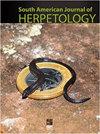两种亲缘关系密切的蟾蜍头部角化棘的种内、种间和海拔变化
IF 0.7
4区 生物学
Q4 ZOOLOGY
引用次数: 0
摘要
摘要环境、栖息地和伴随的梯度等生态因素会影响物种的形态特征。不同的环境条件可能会导致一个物种种群或密切相关物种之间的表型差异,从而导致性状进化,也可能导致表型可塑性,作为对生活栖息地非生物和生物变化的反应。蟾蜍科(两栖纲:无尾蟾蜍)包含具有基本表型特征的定型蟾蜍,如干燥的疣状皮肤,其特征是多刺。角质化的刺在以前对蟾蜍属的研究中被处理过。研究的重点是形态形状差异,主要是种内变异,但生态参数没有得到充分的研究。在这项研究中,我们测试了土耳其蟾蜍和疣状蟾蜍的高度与角质化棘强度之间的关系。我们还根据棘度评估了这两个物种的种内和种间变异。根据卡方检验的结果,蟾蜍的角质化棘的强度在性别之间存在统计学上的显著差异。雄性大多皮肤光滑,没有刺,而大多数雌性则有轻微的角质化刺。疣状芽孢杆菌的角质化棘的强度在性别之间没有差异。对于种间变异,我们发现雌性标本在种间角质化强度方面存在差异。因此,所有蟾蜍雌性都有严重的角质化棘,而大多数疣状蟾蜍雌性的皮肤光滑。我们发现这两个物种的角化棘的高度和强度之间存在统计学上显著的负相关关系。因此,我们假设观察到的与脊椎强度相关的差异表明了物种之间的物种特异性特征进化。海拔之间的差异可能与当地气候条件和生活空间中对抗捕食者的防御策略有关。本文章由计算机程序翻译,如有差异,请以英文原文为准。
Intra- and Interspecific and Elevational Variation in Keratinized Spines on the Head in Two Closely Related Bufo Species
Abstract. Ecological factors such as environment, habitat, and accompanying gradients affect the morphological characteristics of species. Different environmental conditions may induce phenotypic dissimilarities in populations of a species or between closely related species causing character evolution, or they may cause phenotypic plasticity as a response to abiotic and biotic changes in living habitats. The family Bufonidae (Amphibia: Anura) contains stereotypical toads with basic phenotypic features like dry warty skin characterized by spinosity. Keratinized spines were handled in previous studies on the genus Bufo. The studies were focused on the morphological shape differences and mostly intra-specific variations, but ecological parameters were not sufficiently investigated. In this study, we tested the relationship between elevation and the intensity of keratinized spines for Bufo bufo and B. verrucosissimus species in Türkiye. We also assessed intra and interspecific variations for both species based on the spinosity. According to the results of a chi-squared test, a statistically significant difference was found in the intensity of keratinized spines between the sexes of B. bufo. Males mostly had smooth skin without spines, whereas most females had slightly keratinized spines. There was no difference in terms of intensity of keratinized spines between sexes in B. verrucosissimus species. For interspecific variations, we found that female specimens differed in terms of intensity of keratinized between species. Accordingly, all B. bufo females had heavily keratinized spines, whereas most of B. verrucosissimus females had smooth skin. We found statistically significant negative relationships between elevation and intensity of keratinized spines for both species. Accordingly, we assume that the observed disparity related to the intensity of spines demonstrates a species-specific character evolution between species. The differences between elevations might be associated with local climatic conditions and defense strategies against predators in the living space.
求助全文
通过发布文献求助,成功后即可免费获取论文全文。
去求助
来源期刊
CiteScore
1.50
自引率
0.00%
发文量
10
期刊介绍:
The South American Journal of Herpetology (SAJH) is an international journal published by the Brazilian Society of Herpetology that aims to provide an effective medium of communication for the international herpetological community. SAJH publishes peer-reviewed original contributions on all subjects related to the biology of amphibians and reptiles, including descriptive, comparative, inferential, and experimental studies and taxa from anywhere in the world, as well as theoretical studies that explore principles and methods.

 求助内容:
求助内容: 应助结果提醒方式:
应助结果提醒方式:


